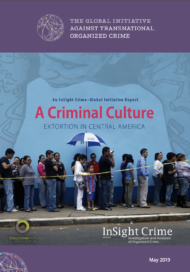Posted on 04 Jul 2019
Extortion is becoming more pervasive in Mexico, in a region already notorious for its criminal culture. Can Mexico learn from its southern neighbours’ experience of underground criminal-economy regimes?
‘In many parts of Central America, extortion is a way of life. In certain countries, principally those of the Northern Triangle (i.e. El Salvador, Guatemala and Honduras), few […] escape its clutches. Extortion has become so ubiquitous in parts of the region that it is embedded in the culture. Most victims are powerless to resist, as are the governments that are supposed to protect them.’
This is one of the starkest findings of A criminal culture: Extortion
in Central America, a report jointly produced by the Global
Initiative Against Transnational Organized Crime and InSight Crime.
The report, published in May 2019, uncovers ways in which criminal gangs
operating in the Northern Triangle countries extort individuals and businesses
through threats and acts of violence, aided by an environment of insecurity in
which the state cannot or will not protect its citizens. Gangs such as the
infamous Maras 13 and 18 use
extortion to maintain territorial control over communities in the region.
This widespread criminal phenomenon leaves people from all socioeconomic
backgrounds vulnerable and threatened, and also impacts the operation of formal
business and informal vendors (both legal
and illegal) in the region. Many companies are now compelled to factor in extortion
fees as part of their regular operating costs, which increases the price of their
goods or services to the consumer. In the Northern Triangle countries,
extortion has become such a normalized feature of society that in El Salvador,
for example, the fees are known as ‘the rent’, and in Honduras as ‘war tax’.
The dynamics of extortion are varied. Payments are not only demanded by
gangs in cash (or by means of electronic money transfers), but are also made in
kind, in the form of goods, such as food, or services (which may include storing
arms or drugs for gang members, money laundering and sexual extortion). People and
businesses alike are compelled to pay the territorial gang fees or provide
services on a regular basis – much like a utility bill or tax. The report also found
that convicted gang members continue to carry out acts of extortion from prison
using phones and relying on co-conspirators to collect the payments or enforce
the threat.
Given the disparate and widespread nature of this form of crime, it is
difficult to accurately evaluate the problem or assess the extent of its
economic impact. The table provides some context, however, with figures from
Attorneys Offices of the Northern Triangle countries. It is
important to note that compounding the challenge in evaluating the problem is
the fact that extortion is notoriously under-reported in the region. In the
three countries, over 90 per cent of extortion-related crimes are not reported
to the police or any other authority (and the low figures are an indication of
this).

Extortion in Mexico
In Mexico the data does not paint a positive picture. For example, the National Crime Victimization and Public Security
Perception Survey, found
that in 2017, 6.6 million acts of extortion took place in Mexico, which
translates to an extortion rate of 7 719 per 100 000 inhabitants; in 93.2 per
cent of these cases, extortion was committed by phone. Nationally, crimes involving
extortion are the most frequent after robbery, and it is the most common form
of crime in 15 Mexican states. However, according to criminal records from the
Mexican government, in 2017 only 5 549 incidents of extortion were reported to
the authorities (a rate of 4.6 for every 100 000 in habitants).
Mexican businesses are also impacted by extortion, albeit to a lesser
degree. The National Victimization Survey of Businesses found that in 2017, 525 000 acts of extortion took
place targeting business, which represents a rate of 1 150 per 10 000 economic
units. After merchandise theft and micro-theft, extortion ranks as the third
most prevalent crime affecting business. Small businesses and service providers
are particularly vulnerable.
Although, in Mexico, less than 8 per cent of victims proceed with payment
following an extortion threat, the pervasive fear created by the threat has an
erosive impact on citizens’ perception of security and in the credibility of
security institutions.
Territorial-based extortion[1] is the most concerning type, given the levels
of violence it generates and the increased costs imposed on businesses. Using the
threat of violence, gangs extort from businesses a regular payment, or ‘tax’, in
return for which they are allowed to operate. This mode of extortion was introduced by the Knights Templar cartel and spread rapidly as it became replicated
by other Mexican criminal organizations. It has allowed criminal organizations
to expand their economic base. Along with trafficking and selling drugs, oil bunkering,
human trafficking and smuggling, and kidnapping, extortion has become a major
source of income for Mexican organized-crime groups, which have become
poly-criminal in nature.
Data on this type of extortion is poor, but, according to one report, the Federal Police have information on territorial-based extortion in
the 32 states of Mexico. Those most affected are the State of Mexico, Chihuahua,
Mexico City, Michoacan, Guerrero, Veracruz, Tamaulipas, Guanajuato, Morelos and
Jalisco.
For example, in Mexico City businesses and restaurants may pay between US$100 and 1 150 a month to the
Tepito Union criminal organization. Public transport operators in the State of Mexico have gone on strike owing to extortion and the violence their drivers
and customers face as a result. During the first five months of 2019, 14 buses were
torched or bombed with grenades. Meanwhile, Mexico’s National Organization of
Oil Businesses stated that criminal groups have targeted gas station companies in
order to sell stolen petrol.
And these are not the only industries affected. Mining companies and mineworkers
in the northern state of Sinaloa have also been extorted by criminal groups. In Morelos, five
criminal gangs have been responsible for extorting municipal authorities for monthly
payments of between US$5 000 and US$25 000.
In the region, controlling extortion should arguably be the most
important goal of government, as it directly clashes with the fiscal and
violence monopolies of the state. And although the Mexican government has made
an effort to introduce measures to prevent phone-based extortion, it is
imperative to develop policies that will encourage citizens to report this
crime to the authorities, and enable sound law-enforcement investigations to be
conducted to help successfully prosecute extortionists and trace where the
money is laundered. Northern Triangle countries have taken some steps in this
direction, but it is unfortunate that the initiatives were not taken earlier.
In 2018, the Global Initiative launched the Coalitions for Resilience project,which was funded under
the auspices of the Canadian government to
help build resilient communities living with extortion in the Northern Triangle
countries, as well as Costa Rica and Panama. The project
has three phases. The research report referred to above was the output of the
first phase – its objective to gain a better understanding of the dynamics and
evolution of extortion in the region, as well as the responses to it so far.
The presentation of the report in May 2019 in the Northern Triangle countries marked
the second phase of the project, which seeks to mobilize a network of some 60 stakeholders
to come up with solutions in the form of a tool (the third phase) that aims to
provide strategies to counter extortion at the municipal level.
[1] Following the typology of extortion
described in ‘A criminal culture: Extortion in Central America’, this is the
type of extortion that businesses and individuals who operate or live in a
criminal organization- or gang-controlled territory are compelled to pay periodically.



